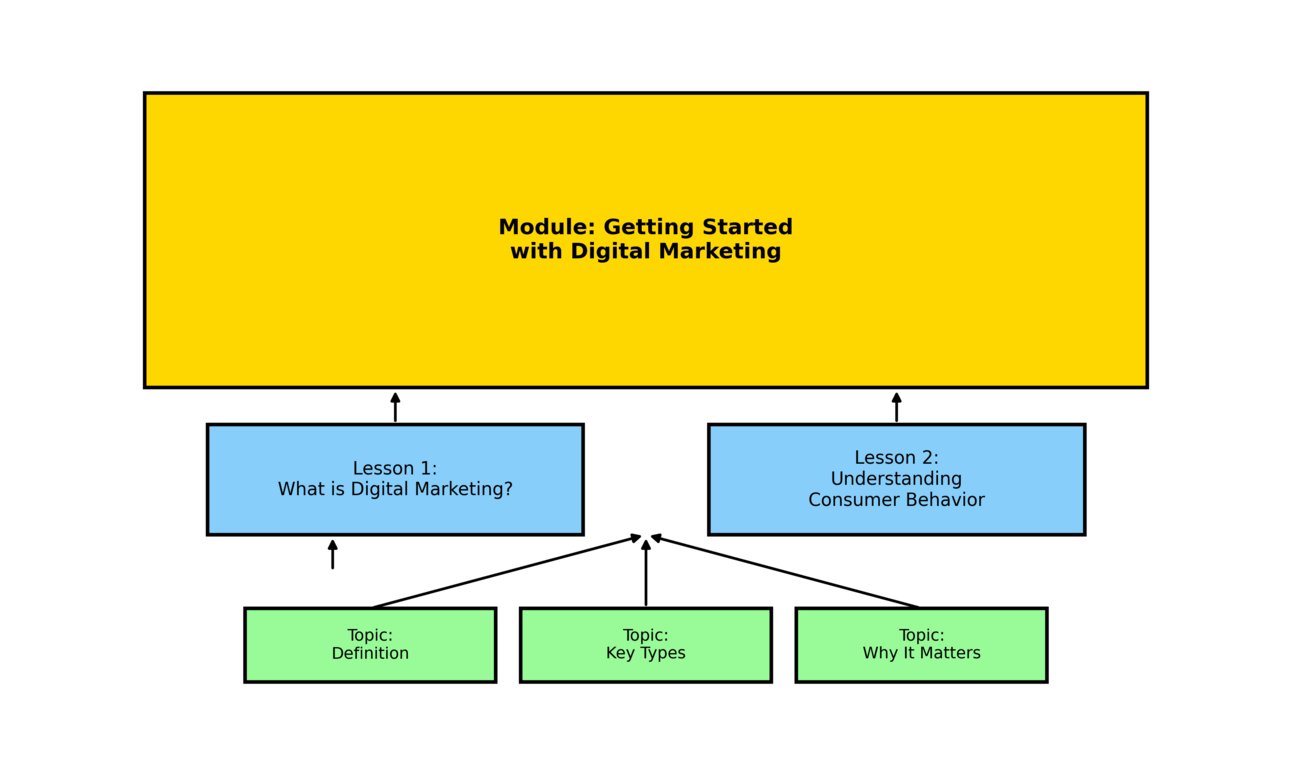- MORPHOICΞS
- Posts
- 🌌Designing Lesson Plans Made Simple: Master Your Courses with AI-Powered Prompts!
🌌Designing Lesson Plans Made Simple: Master Your Courses with AI-Powered Prompts!
You’ve probably stared at your course outline, wondering how to break it into lessons that are both engaging and purposeful. Sound familiar? Let’s simplify this process!

Designing Lesson Plans Made Simple: Master Your Courses with AI-Powered Prompts.

Estimated Reading Time: 5 Minutes — Wednesday, November 27, 2024.
Hey there, Course Creators!
Welcome back to Morphoices: Online Course Creation!


If you’ve ever struggled to break down your course outline into clear, focused lessons, you’re not alone. Many course creators face the same questions:
How do I make my lessons simple but impactful?
How can I ensure they flow logically?
Am I including too much—or not enough?
Good news—you don’t have to figure it out alone! AI-powered prompts can help you plan lessons that are clear, engaging, and perfectly aligned with your learners’ goals.
Let’s dive in and simplify lesson planning together!

Let’s jump in!


Why Lessons Matter (and Why They Can Be Tricky).
Think of your course like a house: modules are the rooms, but lessons? They’re the furniture and decorations that make those rooms useful and inviting. Each lesson needs to have a purpose, teach something specific, and help your students get closer to achieving their goals.
But it’s easy to get stuck—how much should you include? What’s too much? What if you forget something important? That’s where AI prompts come in. They’ll help you map out your lessons so they’re clear, engaging, and perfectly aligned with what your students need.

The Simple Way to Plan Lessons with AI Prompts.
Here’s how you can use AI prompts to create lessons that flow beautifully and keep your learners excited to learn more:

Here’s a visual breakdown of how you can structure your modules, lessons, and topics using AI prompts:


Step 1: Choose Your Starting Module.
Choose one module to focus on first. For example, let’s say your course is about Digital Marketing, and Module 1 is Getting Started with Digital Marketing.
Step 2: Define the Lesson's Core Focus.
What’s the one thing you want this lesson to teach? Keep it simple! For example, your first lesson could be Understanding What Digital Marketing Is.
Step 3: Set a Clear Goal for the Lesson.
Ask yourself: What should students know or be able to do by the end of this lesson? For example, they might learn to explain what digital marketing is and name its key parts.
Pro Tip:
If you’re stuck on a lesson goal, start with the question: “What do I want students to remember or be able to do by the end of this lesson?” This keeps your lesson focused and results-driven.
Step 4: Outline Key Topics to Cover.
What smaller points will you teach to meet that goal? For example, in a lesson about digital marketing, you might cover:
What digital marketing means.
Why businesses use it.
The main types of digital marketing (like social media or email marketing).
Step 5: Plan Interactive Activities.
What can students do to practice what they’ve learned? Maybe they could brainstorm ways to use digital marketing for a small business or list their favorite digital marketing examples.
Step 6: Use AI to Create a Complete Lesson Plan.
Now you’re ready to use an AI tool to help you flesh out these ideas. You’ll give it details like your lesson goal and topics, and it will create a detailed plan for you. Easy peasy!

The AI-Powered Prompt (for Detailed Lesson Plans)
Here’s the prompt you’ll use to generate a structured, engaging lesson plan:
TASK: The AI-Powered Prompt (for Detailed Lesson Plans)
Design a lesson plan for [module name], focusing on [lesson focus]. The lesson plan should include the following details:
1. **Lesson Title and Description**:
Provide a brief summary of what this lesson will cover and its purpose in the module.
2. **Learning Objectives**:
Clearly define what learners should achieve by the end of the lesson. Focus on skills, knowledge, or competencies gained.
3. **Key Topics to Cover**:
List the essential topics that will be addressed in the lesson, in a logical sequence that will engage learners from start to finish.
4. **Activities or Exercises**:
Suggest activities or exercises that can help learners apply what they’ve learned. Consider interactive tasks like quizzes, case studies, or practical applications.
5. **Expected Outcomes**:
Describe the specific outcomes learners should be able to demonstrate after completing the lesson. What will they know or be able to do?
Ensure the lesson is structured in a way that aligns with the overall course goals and contributes to the module’s purpose. The lesson should be engaging, practical, and easy to follow.
PARAMETERS:
- **module_name**: Specify the name of the module (e.g., "Module 1: Introduction to Digital Marketing").
- **lesson_focus**: Define the lesson's specific topic (e.g., "Understanding Consumer Behavior").
Putting the Prompt Into Action.
Let’s see this in action with an example. Say you’re working on Module 1: Introduction to Digital Marketing, and you want to focus on Understanding Consumer Behavior.
Here’s how you’d use the AI prompt to plan Lesson 1 in Module 1: Getting Started with Digital Marketing. Follow this structure for any topic!:
TASK: The AI-Powered Prompt (for Detailed Lesson Plans)
Design a lesson plan for [Module 1: Introduction to Digital Marketing], focusing on [Understanding Consumer Behavior]. The lesson plan should include the following details:
1. **Lesson Title and Description**:
'Understanding Consumer Behavior' — In this lesson, learners will explore the various factors that influence consumer decision-making and learn how to apply these insights to marketing strategies.
2. **Learning Objectives**:
By the end of this lesson, learners should be able to:
- Define consumer behavior and its relevance to digital marketing
- Understand the difference between psychographics and demographics
- Apply consumer behavior data to create customer personas
3. **Key Topics to Cover**:
1. Introduction to consumer behavior and its importance in marketing
2. Psychographics vs. demographics
3. The consumer decision-making process
4. Using consumer behavior data for creating customer personas
4. **Activities or Exercises**:
- **Case Study**: Analyze a marketing campaign and identify how consumer behavior data was applied to its success.
- **Practical Exercise**: Create a customer persona for a hypothetical product based on demographic and psychographic information.
5. **Expected Outcomes**:
By the end of this lesson, learners should be able to create detailed customer personas for any digital marketing campaign, using consumer behavior data to guide their strategy.
Actual Results:

Why This Works.
Here’s why using this prompt is a game-changer:
Clear, Measurable Objectives: By defining exactly what learners should be able to do after the lesson, you make sure the lesson has a clear goal and purpose. This helps you create content that stays focused and impactful.
Logical Structure: Breaking the lesson into key topics in a logical sequence ensures learners build their knowledge progressively, without feeling overwhelmed.
Practical Activities: Including interactive exercises like case studies or customer persona creation helps students apply what they’ve learned in real-world scenarios, keeping them engaged and motivated.
Outcome-Focused: The expected outcomes give learners a concrete understanding of what they’ll be able to do after the lesson, making the learning experience goal-driven and meaningful.

Wrap-Up.
Checklist Formatting:
Your wrap-up checklist is excellent, but it could be visually stronger with bullet points or emojis to help it pop:
✅ Why lessons are the backbone of great courses.
✅ How to create goal-driven, simple lesson plans.
✅ The AI prompt formula for instant results.
With these tools in your back pocket, you’re ready to streamline your lesson planning and create a course that’s not only well-structured but also engaging and impactful for your learners.

Happy course planning, and keep creating with confidence!
Until next time,
Valentine.

P. S. — Have you used this prompt for your lessons? Hit reply and let me know how it worked for you!
Reply